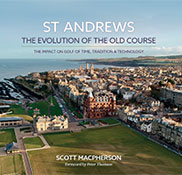GOLF CHAMPIONSHIPS ON SMGD COURSES:
At Close House – Colt Course. Sept 2017. A prestigious European Tour Championship hosted by Lee Westwood.
Broadcast worldwide from Royal Wellington Golf Club, NZ. October 2017. WOW!
The legacy continues.
Co-hosted at the award-winning Millbrook Resort near Queenstown, NZ. 2014 – 2023.
Design Philosophy
The Critical Dimensions of Width, Length and Elevation.
The routing of a golf course and the sequencing of the holes is a critical phase of any design. There is no good course that has a bad routing. As G.C. Thomas, Jr. wrote in 1927, ‘If your mind cannot recall the exact sequence of holes, that course lacks the great assets of originality and diversity.’ Within the routing, and inseparable from it, however are the critical dimensions of width, length and elevation. The clever use of these dimensions takes a golf course beyond a pure examination of golfing skill and into an examination of human nature.
Architects know people relate differently to different levels of risk, reward, fear and opportunity. The varying use of width, length and elevation can unsettle, challenge, encourage, dismay and destroy a golfers mindset when incorporated cleverly. They are the keys that enhance a golfing strategy, engage the golfer and unlock the greatest levels of golfing fun.
Width is perhaps the most important of these dimensions. Incorporating greater width allows greater options, and options are the foundations of good golf strategy. If a fairway is wider, as for example are the famed fairways on the Old Course in St Andrews, a player can choose a route that most suits their game. On a day when a golfer is hitting the ball well, of convivial weather conditions, a player may choose a more direct but dangerous route. On a more difficult day, the golfer may course a longer but safer route. Making strategic golfing decisions like this and attempting their execution is a central test of golf, and one more strongly enhanced on fairways with greater width.
Supporters of the narrow fairways claim the test of accuracy is reduced on wider fairways. But in fact, the opposite can be true. When wide fairways are designed well, a part of the landing area may be shaped to aid a shot into the green. The remaining area however may be shaped to do something as slight as creating an uneven lie for the golfer, or as much as deflecting the ball away from an ideal landing area into a deep hollow, hazard or bunker. This subtlety is a greater virtue to good golf than long grass. While long grass is, on occasion, a legitimate golfing test, losing a ball or the thoughtless act of regularly hacking oneself out is nothing less than a test of strength (and patience). Whereas playing shots from uphill, side-hill or downhill lies takes greater finesse and skill, and is more in keeping with the original spirit of the game- that of adventure.
The second critical dimension is that of elevation. While it is obvious that elevation has a direct impact on the distance a ball will travel (uphill shots fly less and run less, and downhill shots the opposite), more importantly, used cleverly elevation can impact the mind. Our swings are influenced by our sensory perception and variations in the levels of visibility can directly influence the poise of a golfer. So if a golfer is required to make a shot that their eyes tell them is difficult, most golfers are less likely to feel confident, and as a result, less likely to make a good swing. A factor as simple as the elevation of the tee- or lack thereof- can cause, to various degrees, a players’ swing to quicken, tighten, shorten, lose its rhythm and timing, and all manner of other near-fatal errors.
Elevation change impacts strategy. I like elevation change most when there is clear visibility form the tee, but an offline tee shot may result in the player being in a position from where the flag is partially or completely hidden. This is called ‘deferred danger’. The player may not be punished immediately, but the difficulty in executing the next shot is enhanced. A course with some quality elevation changes that are designed with a type of sensitivity that does not give up its secrets immediately and can be overcome with a combination of skill and intelligence, must be considered superior. Indeed, as Alistair MacKenzie wrote in 1920, ‘A good golf course is like good music or good anything else: it is not necessarily a course that appeals the first time one plays over it, but one which grows on the player the more frequently he visits it.’
Length is the third critical dimension. The importance of length is to test a players’ ability to hit shots to a target from distance. The best courses get players of all calibres using all the clubs in their bag – and ideally at least twice. With technology constantly changing and modern players hitting the ball further than ever before, it is quite a challenge to do this with any confidence however – especially on Par 4’s and 5’s. But with more teeing grounds and the greater staggering there of, it can be done and is important.
The best holes in golf will remain the short, engaging par 4’s, flanked with hazards such as the 10th hole at Riveria Country Club in America. Long hitters will try to drive them, but the hole will be won more often by brains rather than brawn. Longer holes must continue to be sought by architects however, but more than ever it must be combined with accuracy because as William Flynn wrote in 1927 ‘accuracy in the play signifies skill and skill is generally the master of brute force…’
The best golf courses in the world are fun and engaging. Rewards are generally proportional to risks, and not all is as it seems the first time you play. The dimensions of width, elevation and length are physical conditions that deliver a superlative golfing experience. They are consistent elements to the best courses, and combined with the routing, should be the corner stones of any golf course design.
AWARDS
 Winner
Winner
Excellence in Compliance Award
Royal Wellington Golf Club
 Scott awarded by GEO as a Sustainable Golf Champion
Scott awarded by GEO as a Sustainable Golf Champion
PUBLICATIONS
 St Andrews
St Andrews
The Evolution of the Old Course
by Scott Macpherson
TESTIMONIALS
"RWGC set out to build the best club golf course in New Zealand and to be one that golfers from all around the world will travel to play. We are confident that ambition is being realized."
Peter Cutfield, Chairman, Royal Wellington Golf Club, NZ



